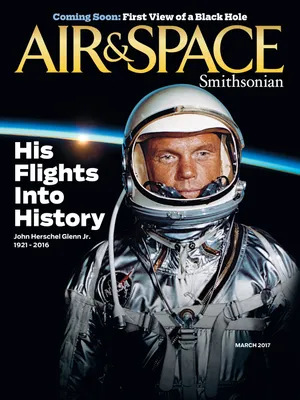Baby Boom: A Concorde for the 21st Century?
This Denver-based company wants to revive the supersonic airliner.
/https://tf-cmsv2-smithsonianmag-media.s3.amazonaws.com/filer/f6/db/f6db9e12-b5ec-4640-86ca-740fbc4c0cd3/24f_fm2017_boomxb1andboom2_live.jpg)
Inside a hangar at Denver’s Centennial Airport last November, Blake Scholl, chief executive of Boom Technology, told a crowd he was going to bring back supersonic air travel. He pulled back a curtain to reveal a full-scale model of the Boom XB-1 supersonic demonstrator—the “Baby Boom.” At 68 feet long and with a tiny 17-foot wingspan, the two-seat, three-engine aircraft looks like a jet fighter that’s been cartoonishly stretched. Once the real demonstrator is built and undergoing tests later this year, Scholl says it will be the fastest civilian airplane ever flown, and the technologies it will test will lead to a fleet of Boom supersonic airliners operating as early as 2023.
Talk of supersonic commercial air travel always starts with the Concorde, which operated from 1976 to 2003. That British-French airliner flew at a top speed of Mach 2.02, or about 1,300 mph at cruising altitude. Though largely a technical success, the Concorde was a commercial failure. Only 16 aircraft were sold, and only two airlines bought them—British Airways and Air France. With tickets for transatlantic flights selling for the equivalent of $15,000 to $20,000 in today’s dollars, there simply weren’t enough passengers to regularly fill the airliner’s 100 seats. And the sonic booms produced by the flights created a practical obstacle: a ban on supersonic flight over land.
Yet Scholl believes he can overcome some of these problems by creating a more efficient, faster aircraft. He laments that “we’re about to have self-driving cars, but we’re still flying essentially 1960s aircraft designs.” Boom, he says, is using computer simulations of wind tunnels to develop a 45-seat carbon fiber jetliner that will be at least 30 percent more efficient than the Concorde.
But being more efficient doesn’t exactly make it cheap to fly. Bjorn Fehrm, an aeronautics analyst in France who has been watching Boom’s developments, estimates that for a flight between New York and London, the proposed Boom airliner’s fuel consumption per seat will be about three times that of a modern wide-body. Gas guzzling played a big part in the Concorde’s out-of-reach ticket prices; Boom’s relative efficiency could put costs at around $5,000 for a round trip, about the same price range of a transatlantic business class ticket today. And at Mach 2.2, the flight time would be halved: from seven hours to just over three.
After subsonic tests around Denver, the two-seat demonstrator will move to just outside Edwards Air Force Base in California for testing of its unique propulsion system at supersonic speeds. Fehrm believes the greatest challenges will be the engine intake and exhaust. Whereas the Concorde got past the sound barrier by using afterburners, Fehrm says Boom intends to skip the add-on thrust and instead use three medium bypass turbofans—engines that Scholl says will be more efficient and quieter, but which don’t currently exist. The demonstrator will use an off-the-shelf General Electric turbojet engine; Boom is still developing the airliner’s custom engine. “You can’t just take a normal nacelle [engine housing]; you need to have a variable intake and an advanced nozzle,” Fehrm says. “It’s really rocket science.”
Boom’s chief engineer, Joe Wilding, is used to hearing people doubt that the team can pull it off. “But when we actually talk to them about the details, they come around,” he says. “Concorde’s designers didn’t have the technology for efficient supersonic flight. Today we have improved materials, aerodynamics, and propulsion, enabling affordable supersonic travel.” In fact, Boom has already succeeded in attracting financing and partnerships, including Virgin Group. Virgin Galactic is assisting with the test flights and manufacturing, and the company’s airline has optioned the first 10 airliners off the production line; an undisclosed European carrier has options for another 15.
The team at Boom is just a part of an emerging supersonic renaissance. NASA is working on its single-seat QueSST aircraft to find a way to achieve supersonic flight without the characteristic sonic boom (that is not an initial goal of Boom’s airliner). Aerion Corporation of Reno, Nevada, has been working with Airbus on the AS2, a quiet supersonic business jet intended to persuade regulators to lift the ban on overland flights. But it’s only designed to carry eight high-spending executives.
Blake Scholl and his team of engineers at Boom know that achieving their goal will not be easy. But on the night the company revealed its model, Boom’s hangar was filled with the sense that the XB-1 represents the first step in a new age of supersonic passenger travel.
